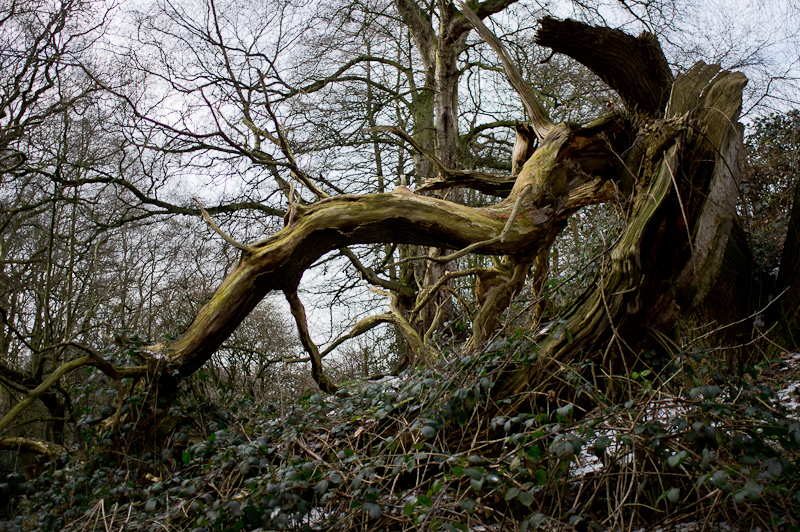We used to call it the Cubs Sett. The family that used it forty years ago were in the habit of crossing a road which divided their wood, and one day, I found that the male badger had paid the price. He lay at the side of the road, where his path passed under the barbed wire and out onto the tarmac.
That night, I went to watch the sett to see what other badgers were there, and was rewarded by a long session with the mother and three young cubs. They came up from a hole at the base of a large tree and spent a long time socialising on the earth mound, grooming themselves and each other, playing follow-my-leader, biting mother’s tail – all the usual enthusiasms of young badgers.
A few days later, I was returning to the sett to check on the family, but when I came to the point where the badger path crossed the road, I came across another badger corpse – the mother badger had also fallen victim to the traffic.
I carried on to the sett and climbed the tree above the main hole, sitting on a lower branch so that my scent would not betray me. I was concerned in case the cubs had not yet weaned, and I was wondering whether I would have to catch the cubs and bottle-feed them. However, they came up and after some perfunctory play, went off into the meadow and seemed to be hunting fairly well, as far as I could see.
Over the next few weeks, I spent a lot of time with the orphaned cubs who quickly got used to my scent and accepted my presence without fear. I sat beside the hole, rarely having to wait more than ten minutes before they emerged, and had a close-up view of their play and mock fights.
 When they went off to begin their night’s hunting, I followed behind. As they snuffled in the grass, they let me put my torch a few inches from their nose to see what they were doing. Some nights during that summer forty years ago, I followed the growing badgers into the small hours, watching them explore the fields and woodland, developing their expertise in catching earthworms and other small prey.
When they went off to begin their night’s hunting, I followed behind. As they snuffled in the grass, they let me put my torch a few inches from their nose to see what they were doing. Some nights during that summer forty years ago, I followed the growing badgers into the small hours, watching them explore the fields and woodland, developing their expertise in catching earthworms and other small prey.
As autumn approached, the young badgers began to become more wary of me and gradually their behaviour changed to what would be expected of wild animals. Over the years since then, I have watched them and their descendents emerge at dusk to go about their nightly business.
This afternoon, I visited their neighbourhood. There was fresh soil in the mounds outside the favourite holes used by the clan, which are forty yards along the bank from where the orphaned cubs lived. The tree that protected the entrance to their home has died, and is slowly falling to earth.
 It felt strange to see the tree in its slow motion fall, and to think of the generations of badgers which have lived beneath it. And also to think of the people for whom the tree would have seemed a permanent fixture in the landscape. How many others have watched the badgers playing under its branches? Where did the badgers live when the tree was a sapling? Awareness grows of the churn of life, of change in the shape of the earth and its living things, of death as part of life.
It felt strange to see the tree in its slow motion fall, and to think of the generations of badgers which have lived beneath it. And also to think of the people for whom the tree would have seemed a permanent fixture in the landscape. How many others have watched the badgers playing under its branches? Where did the badgers live when the tree was a sapling? Awareness grows of the churn of life, of change in the shape of the earth and its living things, of death as part of life.

1 thought on “Death of a Tree”